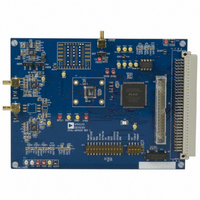EVAL-AD7655CB Analog Devices Inc, EVAL-AD7655CB Datasheet - Page 6

EVAL-AD7655CB
Manufacturer Part Number
EVAL-AD7655CB
Description
BOARD EVAL FOR AD7655
Manufacturer
Analog Devices Inc
Series
PulSAR®r
Specifications of EVAL-AD7655CB
Number Of Adc's
1
Number Of Bits
16
Sampling Rate (per Second)
1M
Data Interface
Serial, Parallel
Inputs Per Adc
4 Single Ended
Input Range
0 ~ 2 V
Power (typ) @ Conditions
120mW @ 1MSPS
Voltage Supply Source
Analog and Digital
Operating Temperature
-40°C ~ 85°C
Utilized Ic / Part
AD7655
Lead Free Status / RoHS Status
Contains lead / RoHS non-compliant
EVAL-AD76XXCB
Figure 11 is the setup screen where ADC device selection, test
type, input voltage range, sample rate and number of samples
are selected.
DC TESTING - HISTOGRAM
Figure 12 is the histogram screen, which tests the code
distribution for DC input and computes the mean and standard
deviation or transition noise. To perform a histogram test, select
“Histogram” from the test selection window and click on the
“Start” radio button. Note: a histogram test can be performed
without an external source since the evaluation board has a
buffered V
at 0V for bipolar devices. To test other DC values, apply a
source to the J1/J2 inputs. It is advised to filter the signal to
make the DC source noise compatible with that of the ADC.
C26/C41 provide this filtering.
AC TESTING
Figure 13 is the FFT screen, which performs an FFT on the
captured data and computes the SNR, SINAD, THD and SFDR.
Figure 14 is the time domain representation of the output. To
perform an AC test, apply a sinusoidal signal to the evaluation
board at the SMB inputs J1 for IN+ and J2 for IN-. Low
distortion, better than 100dB, is required to allow true
evaluation of the part. One possibility is to filter the input signal
from the AC source. There is no suggested bandpass filter but
consideration should be taken in the choice. Furthermore, if
using a low frequency bandpass filter when the full-scale input
range is more than a few Vpp, it is recommended to use the on
board amplifiers to amplify the signal, thus preventing the filter
from distorting the input signal.
REF
/2 source at the ADC input for unipolar parts and
Rev. PrW | Page 6 of 22
DECIMATED AC TESTING (AVERAGING)
The AC performances can be evaluated after digital filtering
with enhanced resolution of up to 32 bits. Figure 15 is the FFT
screen when decimation is used. Additional bits of resolution
are attained when over sampling by:
where , N = number of bits and 4
DRATIO to the amount of over sampling desired. When using
decimation, the test duration increases with the larger number
of samples taken. The decimated test requires the EVAL-
CONTROL-BRD3.
SERIAL PROGRAMMABEL PORT (AD7610,
AD7612, AD7631, AD7634, AD7951)
Figure 16 is a screen showing the flexible serial programmable
port (SPP) used on the AD7610, AD7612, AD7631, AD7634
and AD7951 iCMOS ADCs. The SPP can be used in any serial
mode and allows the configuration of: unipolar and bipolar
input ranges, mode selection, straight binary or 2’s complement
output coding, and power down. The software demo allows two
different configurations and alternates between these two every
ten samples. To use just one range or mode, simply enter the
same values into both “A” and “B” configuration windows. Note
that when using the unipolar input ranges, a common mode
voltage must be provided externally (DC coupled) as the board
is configured with the common mode = 0V
f
OVERSAMPLE
=
4
Preliminary Technical Data
N
f *
SAMPLE
N
.= the DRATIO. Set the




















